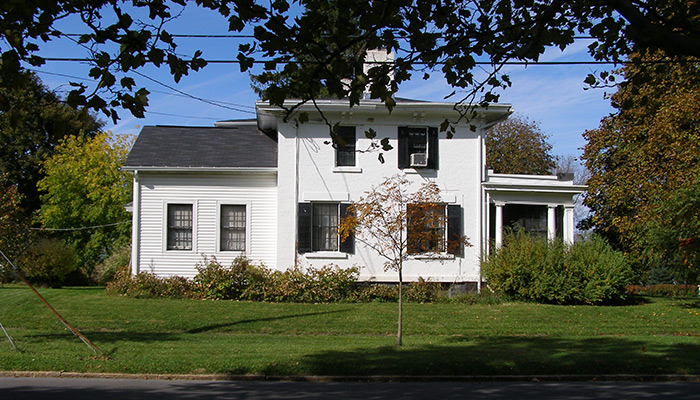Scottholm
Stop #17
2686 East Genesee Street / Original Scott House
- Built: Mid-19th century
- Architect: Unknown
This Italianate style farmhouse was the original Scott house from which Scottholm subdivision takes it’s name. In the late nineteenth century, the home and the adjacent farm were owned by Benjamin Scott. who lived there until his death, circa 1910. At that time the 140 acres were purchased by investors under the auspices of the Scottholm Company. According to a 1916 newspaper, the Scotts used this home as an inn for travelers on the Genesee Turnpike.
After the farmland was sold to Amon Sanderson in 1914, the house was sold to and rehabilitated by E.A. O’Hara in 1915. His father, Edward H. O’Hara was a well-known publisher of the Syracuse Herald. E.A. O’Hara was also a journalist and was president and publisher of the Herald-Journal. He ‘modernized’ the house, with electricity and the entry porch. The O’Hara family owned the house until 1969.
The building is square in plan, with Italianate details, capped by belvedere with arched windows. Italianate style houses on Syracuse’s Eastside were built mostly in the third quarter of the nineteenth century. They pre-date Syracuse’s suburban expansion to the East and the laying out of the new residential grids that mark the first new residential developments in the area. Thus, the Italianate houses quickly tell us where the old roads were. The houses mostly faced major travel routes, and these also often indicate the locations of prosperous farms, all of which, like the Scott Tract, were subsequently built over, especially from 1880 through 1930.
Italianate houses are usually two to three stories high, square or rectangular in plan, with low-pitched hip, gable, or shed (roof with one slope) roofs, often topped by a belvedere. They may be brick with pressed metal, stone, or wood ornamentation, or wood with wood ornamentation. The Italianate Style evolved from the earlier Italian Villa Style. A popular house style, Italianate was also favored for commercial buildings in the late 19th Century.
See:
“An Old House Modernized Without Losing Any of Its Original Attractiveness and Simplicity,” The Syracuse Herald (Apr. 16, 1916).
